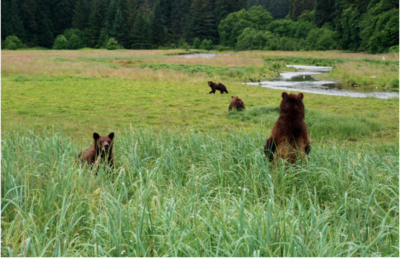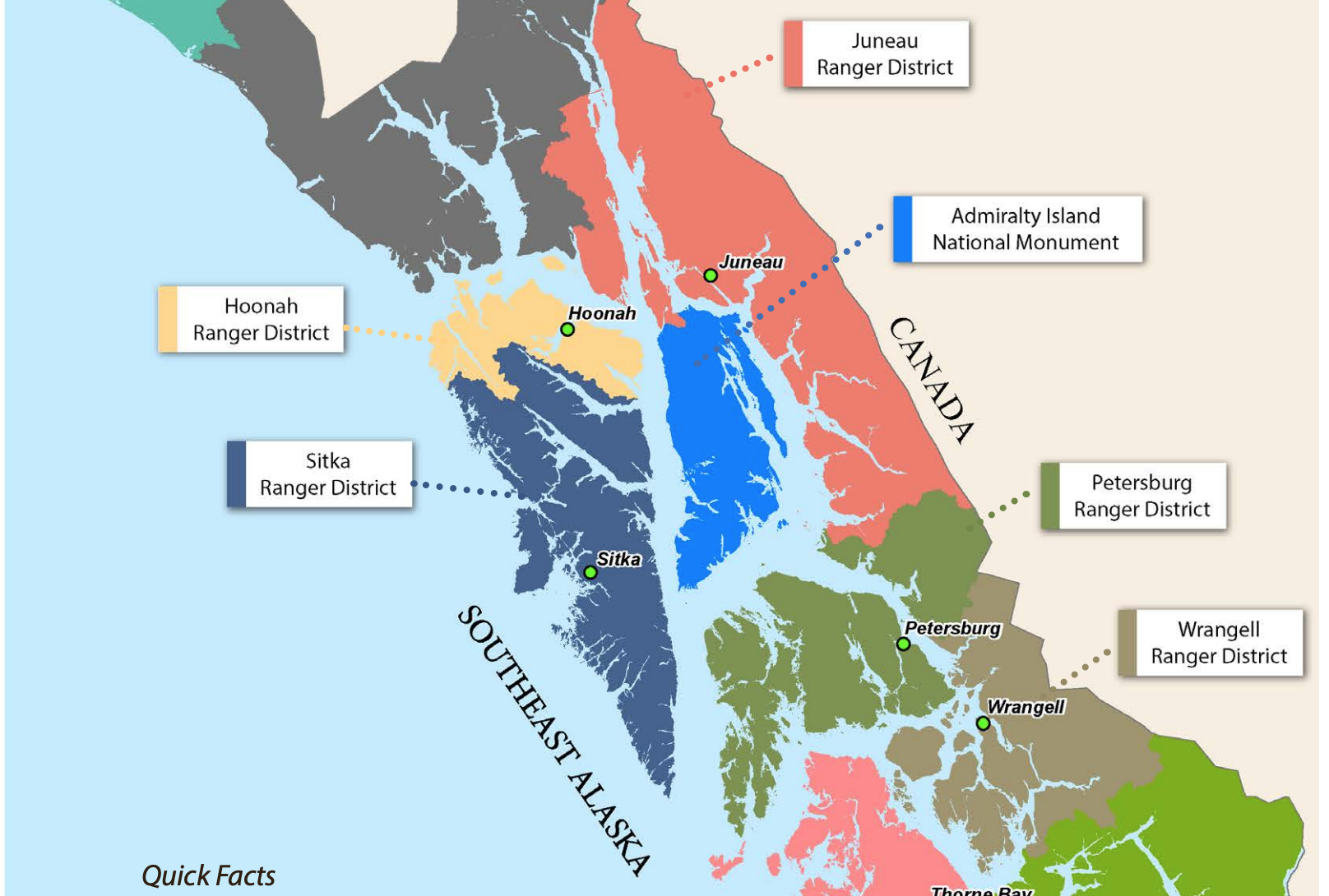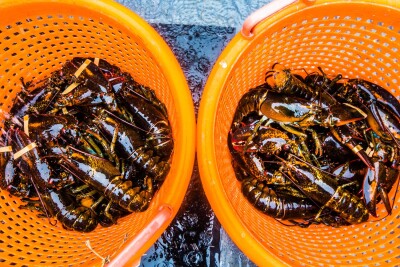More than 9 million acres of Southeast Alaska's 16.7 million-acre Tongass National Forest could lose clearcutting protections with a proposed repeal of the 2001 Roadless Rule.
The U.S. Forest Service will publish its draft environmental impact statement in the Federal Register this week with a preferred alternative to remove all protections for the roadless acres. A 60-day comment period will follow publication.
The statement provides analysis of six alternatives related to the management of the Tongass.

Bears in the Kootznoowoo Wilderness, Tongass National Forest. Don MacDougall/U.S. Forest Service photo
The alternatives range from no action to the removal of the Tongass from the 2001 Roadless Rule (details below). The Department of Agriculture has identified Alternative 6, which is a full exemption, as its preferred alternative. A final decision is expected in 2020.
"As an Alaska salmon troller, I am increasingly dependent on coho salmon reared in the watersheds of Southeast Alaska. Coho live at least a year in fresh water and need the habitat provided by old growth forests," said 2007 NF Highliner Eric Jordan of Sitka, Alaska. "Meanwhile, the forest service still has a huge list of salmon habitat restoration projects needing funding from the previous era of Industrial clear cut logging in Southeast Alaska. "
The Tongass produces more salmon than all other national forests combined, according to Trout Unlimited, and the fishing and tourism industry supported by the intact forest account for more than 25 percent of local jobs in the region.
"People throughout Alaska and the rest of the country depend on the productive rivers and wild fish of the Tongass for food, jobs, and recreation," said Austin Williams, Trout Unlimited’s Alaska legal and policy director. "We urge anyone who shares these values to comment to the Forest Service and urge them to uphold the Roadless Rule and conserve key areas of the Tongass, including the highest quality salmon-producing watersheds within the Tongass 77.”
In 2001, President Bill Clinton established the Roadless Rule for more than 58 million acres of undeveloped national forest nationwide. President George W. Bush sought to reverse the policy for the Tongass but was barred by a federal judge's reinstatement of the Roadless Rule.
Last year, the state of Alaska requested that the U.S. Secretary of Agriculture exempt the Tongass from the 2001 Roadless Rule, which protects old growth forests and critical salmon habitat from clearcutting and the development of logging roads.
"The latest Tongass Forest Plan by the Trump Administration is further proof that aliens can take over human minds," added Jordan. "No sane human being would propose, much less approve, this draconian money-losing plan to destroy wildlife and fisheries habitat in the Tongass Forest."
- Alternative 1 takes no action and would leave all of Alaska under the 2001 Roadless Rule, including the Tongass National Forest.
- Alternative 2 provides regulatory protection for the majority (89%) of key watersheds inside roadless areas and would convert 18,000 old-growth acres and 10,000 young-growth acres previously identified as unsuitable timber lands to suitable timber lands.
- Alternative 3 provides regulatory protections for all key watersheds inside and outside roadless areas, creates a community priority roadless designation that allows for recreational development and timber sales under 1 million board feet, and would convert 76,000 old-growth acres and 14,000 young-growth acres previously identified as unsuitable timber lands to suitable timber lands.
- Alternative 4 restricts harvest and road-building activities in scenic viewsheds and most (88%) key watersheds inside roadless areas and would convert 158,000 old-growth acres and 15,000 young-growth acres previously identified as unsuitable timber lands to suitable timber lands.
- Alternative 5 would remove 2.3 million acres from roadless area designation, protects some (59%) key watersheds, and would convert 165,000 old-growth acres and 17,000 young-growth acres previously identified as unsuitable timber lands to suitable timber lands.
- Alternative 6 (preferred) would exempt the Tongass National Forest from the 2001 Roadless Rule and is fully responsive to the state of Alaska’s petition. The alternative would remove all 9.2 million acres of inventoried roadless acres and would convert 165,000 old-growth acres and 20,000 young-growth acres previously identified as unsuitable timber lands to suitable timber lands.
This draft statement is specific to the Tongass National Forest. The Chugach National Forest would remain under the 2001 Roadless Rule.
The Forest Service is scheduling a series of public meetings and subsistence hearings. A list of those meeting locations will be available on the Alaska Roadless Rule project website.
Public comments will be accepted until midnight Alaska time on Dec. 17, 2019. Comments can be submitted in writing online, via email or fax, by mail, or in person.
Online: www.fs.usda.gov/project/?project=54511
Email: akroadlessrule@fs.fed.us
Mail: USDA Forest Service
Attn: Alaska Roadless Rule
P.O. Box 21628
Juneau, Alaska, 99802
Fax: 907-586-7852
In-person: Forest Service
709 W. 9th St., Room 535B
Juneau, Alaska 99801







